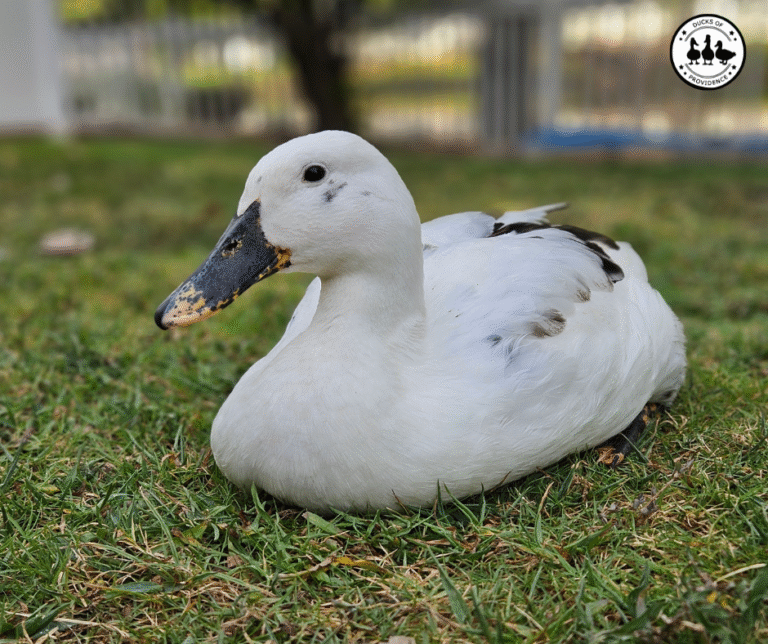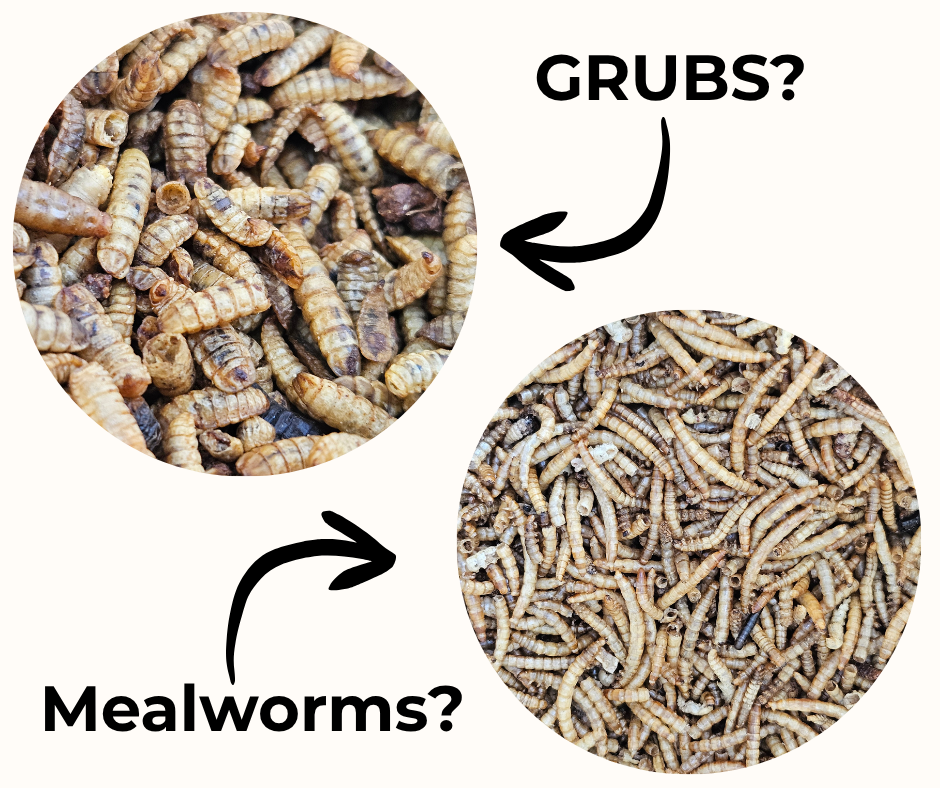
Mealworms and Grubs for Ducks: Nutrition, Benefits, and Best Brands
If there is one sound that makes every duck in my flock drop whatever they are doing and come running, it is the rattle of the treat container. The moment they hear it, heads pop up, wings stretch, and a chorus of excited quacks fills the air. It does not matter if they are napping, preening, or splashing in the pool. When they hear that sound, they know it is snack time.
Mealworms and grubs are every duck’s favorite treat, and I completely understand why. These tiny insects are like crunchy little nutrient powerhouses packed with protein, calcium, and essential amino acids. In the wild, ducks naturally forage for insects, worms, and larvae as part of their diet. They dig in the soil, sift through leaves, and dabble in the water to find whatever little creatures are hiding below the surface. Offering mealworms or grubs at home mimics this natural behavior, turning snack time into both a delicious and enriching activity.
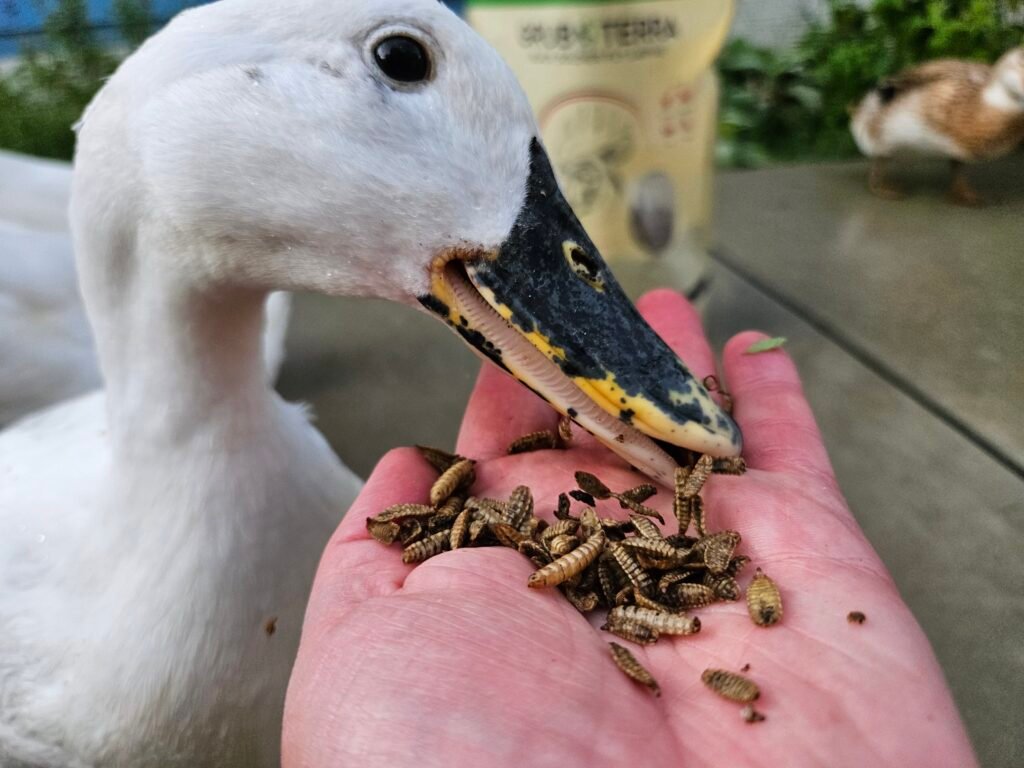
As a duck mom and a scientist, I like to know exactly what I am feeding my flock and why it matters. While it is tempting to shower them with handfuls of these treats (and believe me, I have been guilty of it more than once), moderation and understanding are key. Mealworms and black soldier fly larvae, often called BSFL or simply grubs, each have unique nutritional profiles and benefits. Knowing how they compare helps you make the best choice for your ducks’ health, whether you are supporting feather growth, egg production, or simply giving them a well-deserved snack.
In this post, we will look closely at what mealworms and grubs are, how they differ, and how they are produced. We will explore their nutritional value, talk about when and how to feed them, and compare the best brands available. I will also share my own experience with Grubbly Farms, GrubTerra, and Hatortempt, three brands I trust and have partnered with as an affiliate because they consistently deliver products that make my ducks and me very happy.
Ducks of Providence is free, thanks to reader support! Ads and affiliate links help us cover costs—if you shop through our links, we may earn a small commission at no extra cost to you. Thanks for helping keep our content free and our ducks happy! 🦆 Learn more
Why Ducks Love Insects
Ducks are natural foragers with an instinctive drive to search for food throughout the day. In the wild, their diet is far more diverse than many people realize. It includes aquatic plants, seeds, small crustaceans, snails, worms, and a wide range of insects. Insects play a particularly important role because they are rich in protein and essential amino acids that ducks need for feather production, muscle development, and egg formation.
From a biological standpoint, foraging is more than just eating. It is a complex behavior that stimulates both body and mind. Ducks use their bills to probe and sift through soil, mud, or vegetation, guided by an extraordinary network of nerve endings called Herbst corpuscles. These specialized sensory cells allow them to detect even the tiniest movement or vibration underground, helping them locate hidden insects and larvae with remarkable precision.
Feeding insects such as mealworms and black soldier fly larvae at home is one of the best ways to mimic this natural behavior. It allows domestic ducks to express their natural instincts even in a controlled environment. The activity of searching, pecking, and splashing while foraging provides physical exercise and mental stimulation, which in turn reduces boredom and stress. A stimulated duck is a happy and healthy duck.
There is also a nutritional reason why ducks find insects so irresistible. Insects are a dense source of protein and fat, two nutrients that are crucial for maintaining body temperature, building new feathers during molting, and supporting overall vitality. The scent and texture of insects trigger natural feeding responses, much like the way the smell of fresh grain excites them during feeding time. Even ducks that are usually picky eaters rarely turn down a handful of crunchy mealworms or grubs.
In short, insects satisfy both the biological and behavioral needs of ducks. They provide essential nutrients and offer the kind of foraging experience that keeps ducks physically active, mentally engaged, and emotionally content.
Meet the Bugs: Mealworms and Grubs
When it comes to insect-based treats for ducks, mealworms and grubs are the two most common options. They may look similar at first glance, but they come from entirely different insect species and offer distinct nutritional profiles. Understanding what they are and how they differ helps you make the best decision for your flock.
Mealworms
Mealworms are the larval stage of the darkling beetle, Tenebrio molitor. They have a long, segmented body covered in a thin exoskeleton and thrive in dry environments. These larvae are traditionally raised on grain-based feed, such as bran, oats, or wheat, which contributes to their rich protein content. Dried mealworms typically contain about 50 percent protein and moderate amounts of fat, which makes them an excellent source of quick energy.

Because they are high in protein but relatively low in calcium, mealworms are ideal for growing or molting ducks but should be balanced with calcium-rich feed for laying hens. Ducks that receive an excess of mealworms without additional calcium may experience shell quality issues over time. Despite that, mealworms remain one of the most beloved snacks in any flock. The crunchy texture and slightly nutty aroma seem to be irresistible to ducks.
Grubs
Grubs, or black soldier fly larvae (BSFL), come from the species Hermetia illucens. Unlike mealworms, these larvae are typically raised on recycled plant materials such as fruits and vegetables, making them a sustainable and environmentally friendly protein source. BSFL are cream-colored with a thicker body and softer texture compared to mealworms.
Nutritionally, black soldier fly larvae stand out for their exceptional calcium content, which can be up to 50 times higher than that of mealworms. They also contain beneficial fatty acids such as lauric acid, known for its antimicrobial properties that support gut health. The protein content of dried BSFL ranges from 40 to 45 percent, making them slightly lower in protein but richer in minerals and healthy fats.
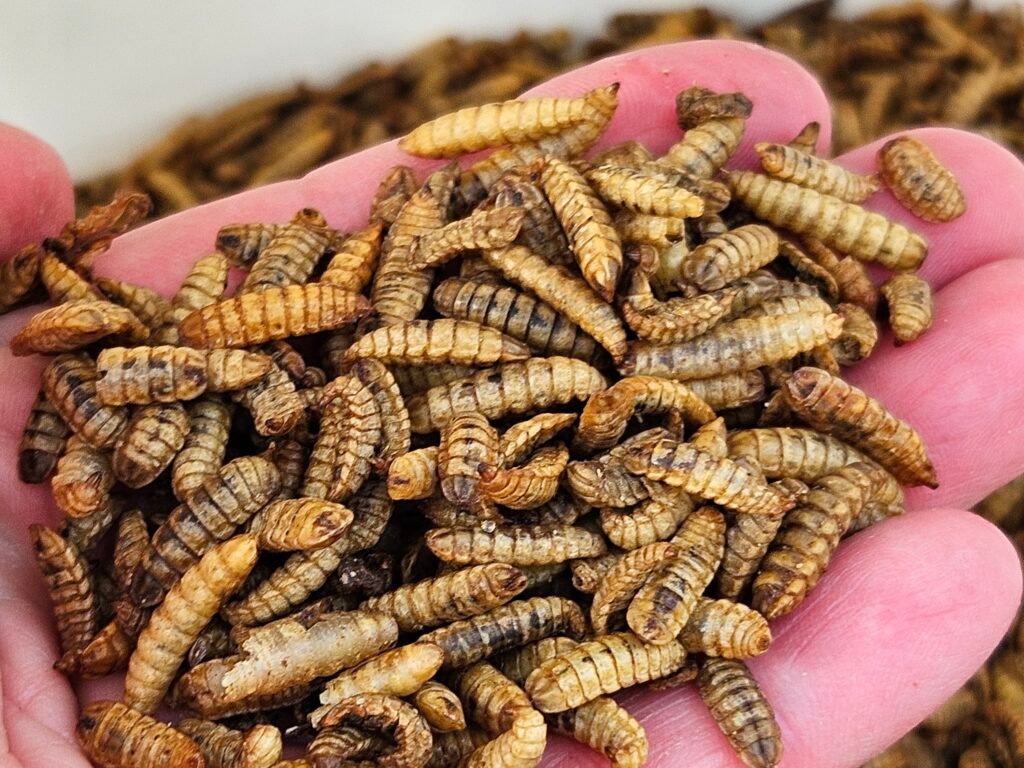
From a sustainability perspective, BSFL farming is one of the most efficient ways to produce animal feed protein. The larvae grow quickly, require minimal land and water, and can convert organic waste into high-value biomass. This not only makes them an excellent feed choice for ducks but also an environmentally responsible one.
Both mealworms and grubs can be fed dried, rehydrated, or even live if available. While their nutrient profiles differ, both offer essential benefits that complement a balanced duck diet. Many duck keepers, including myself, like to rotate between the two to provide nutritional variety and to keep the flock’s enthusiasm high.
Nutritional Value Comparison
Mealworms and grubs are both nutrient-dense treats that offer a variety of benefits for ducks. However, their composition differs in ways that make each one suitable for specific needs. Understanding these differences helps you decide when to offer mealworms, when to choose grubs, and how to balance them in your ducks’ diet.
| Nutrient | Mealworms (dried) | Black Soldier Fly Larvae (dried) |
|---|---|---|
| Protein | 50-53% | 40-42% |
| Fat | 25-30% | 28-35% |
| Calcium | 0.03% | 3-5% |
| Phosphorus | 0.6% | 0.9% |
| Fiber | 6% | 8% |
| Moisture | 5-10% | 5-10% |
| Texture | Crunchy | Softer |
| Sustainability | Moderate | Excellent |
| Best for | Molting and growth | Egg-laying and bone health |
| Duck approval rating | Very popular | Equally popular |
Protein
Protein is the foundation of a duck’s diet and is crucial for muscle development, feather regeneration, and egg production. Mealworms have a slightly higher protein content, which makes them an excellent source of quick energy and support during growth or molting. Ducks that are replacing feathers or recovering from illness especially benefit from the extra boost in protein.
Fat
Fat provides long-lasting energy and helps ducks maintain their body temperature, particularly during colder months. Both insects contain moderate to high amounts of fat, but black soldier fly larvae tend to have slightly more healthy fats, including medium-chain fatty acids such as lauric acid. This fatty acid has natural antimicrobial properties that can support digestive health and improve nutrient absorption.
Calcium
Calcium is one of the biggest differences between mealworms and grubs. While mealworms contain almost no calcium, black soldier fly larvae are one of the richest natural sources of this mineral found in any animal feed. Calcium is essential for strong eggshells, healthy bones, and proper muscle function. For laying ducks, grubs are an especially valuable supplement.
Phosphorus
Phosphorus works together with calcium to maintain strong bones and support energy metabolism. The calcium-to-phosphorus ratio is important, as an imbalance can interfere with mineral absorption. BSFL have a much more favorable ratio than mealworms, making them a more balanced choice when used as a supplement.
Fiber
A moderate amount of fiber aids in digestion and helps regulate nutrient absorption. Both insects provide some fiber from their exoskeletons, although BSFL contain slightly more due to their thicker outer layer.
Moisture
Dried insects contain very little moisture, which gives them their crunchy texture and long shelf life. Rehydrating them in warm water before feeding can make them easier to digest, especially for younger ducks or those recovering from illness.
In summary, both mealworms and grubs are excellent additions to a duck’s diet when used in moderation. Mealworms excel as a protein-rich energy source, while black soldier fly larvae shine as a calcium-rich, well-balanced supplement. Offering both on rotation ensures that your ducks receive a diverse range of nutrients that support their overall health and happiness.
Learn more about the Essential Nutritional Needs of Ducks
How They Are Produced
The growing interest in mealworms and grubs for poultry and pet use has led to fascinating innovations in insect farming. Both species are now produced on a large scale in controlled environments designed to ensure safety, consistency, and nutritional quality. Understanding how these insects are raised and processed gives a better appreciation for why they make such valuable additions to your ducks’ diet.
Mealworm Farming
Mealworms, the larvae of the darkling beetle, thrive in warm, dry environments. Commercial farms raise them in trays filled with grain-based substrates such as wheat bran, oats, or cornmeal. The larvae feed on this substrate while also consuming small amounts of vegetables or moisture-rich feed to stay hydrated.
Over several weeks, the larvae grow and shed their skin multiple times, a process called molting. Once they reach the right size, they are harvested before they pupate into beetles. The harvested larvae are then cleaned and either oven-dried or freeze-dried to preserve them.
Oven-drying uses gentle heat to remove moisture, resulting in darker, crispier mealworms. Freeze-drying involves freezing the larvae and removing water under vacuum conditions, which better preserves nutrients and texture. Both drying methods are safe, and the choice often comes down to personal preference or how your ducks respond to texture.
Black Soldier Fly Larvae Farming
Black soldier fly larvae, or BSFL, are raised very differently from mealworms. These larvae are typically fed on plant-based by-products such as fruits, vegetables, and grains that would otherwise go to waste. This makes them one of the most sustainable protein sources available for animal feed.
The larvae grow rapidly, converting organic material into nutrient-rich biomass with impressive efficiency. Within about two weeks, they reach harvest size and are separated from the remaining substrate through mechanical sifting. The harvested larvae are then cleaned, heat-treated to eliminate pathogens, and dried using either heat or low-temperature drying systems.
Their ability to thrive on agricultural waste means BSFL farming has a remarkably low environmental footprint. It requires less land, less water, and produces minimal greenhouse gases compared to traditional livestock feed production. Many insect farms even recycle the leftover substrate as organic fertilizer, creating a circular system where nothing goes to waste.
Quality and Safety
High-quality insect producers follow strict safety standards, ensuring that the insects are raised in clean environments free from contaminants or harmful residues. They are regularly tested for pathogens, heavy metals, and nutrient composition. This ensures a consistent and safe product for your ducks.
Both mealworms and BSFL are produced through sustainable farming methods that align with modern environmental values. They provide a renewable source of high-quality protein that benefits not only your ducks but also the planet.
When and How to Feed Them
Mealworms and grubs are more than just treats; they are nutritious supplements that can support your ducks’ health throughout the year. Like all high-protein foods, moderation is important. They should complement a balanced diet, not replace it.
How Much to Feed
In general, treats such as dried insects should make up no more than about ten percent of your ducks’ total diet. This ensures they still receive the full range of vitamins and minerals from their regular feed. A small handful per duck a few times a week is usually enough to give them a healthy boost without overdoing it.
During molting or periods of heavy laying, you can offer insects a little more frequently, since your ducks’ protein and calcium needs are higher at those times. You will notice they appreciate the extra energy and nutrients when their feathers are regrowing or their bodies are working hard to produce eggs.
Best Times to Offer Insects
There are certain times when mealworms and grubs are particularly beneficial:
- Molting season: The high protein content helps rebuild feathers and restore body condition.
- Egg-laying periods: Black soldier fly larvae provide extra calcium that supports strong eggshells.
- During or after illness: The easy-to-digest nutrients help with recovery and strength building.
- Cold months: The added fat provides warmth and energy when temperatures drop.
Different Ways to Feed Them
One of the joys of feeding insects is how many ways you can offer them. You can scatter them in the grass or along the edges of your duck run to encourage natural foraging. Mixing them into feed keeps your ducks interested in their daily meals, while floating them in a water dish or small pool turns feeding into playtime.
Ducks love to work for their food, and insects are perfect for enrichment. You can tuck dried mealworms into treat balls, hide them in piles of hay, snufflemats, or sprinkle them in the mud where your ducks like to dig. These activities keep them active, curious, and mentally engaged.
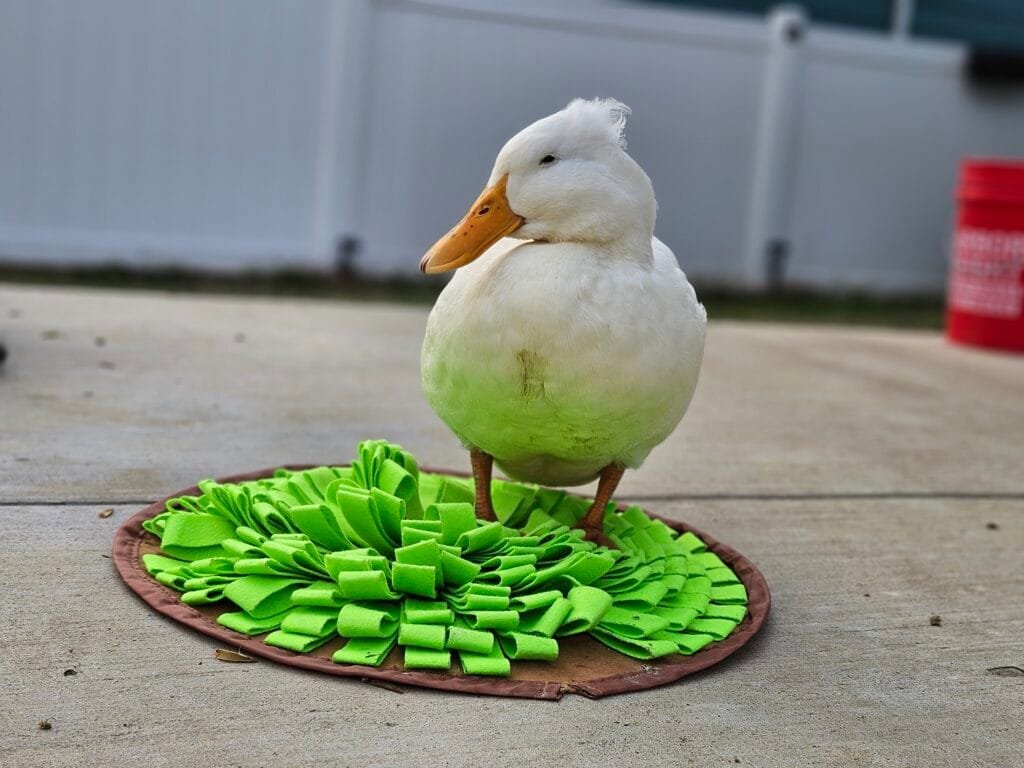
If you prefer to feed them softened, simply soak dried insects in warm water for five to ten minutes. This makes them easier to chew and digest, especially for ducklings or older ducks.
Feeding Ducklings
Ducklings can enjoy insects too, but they should be introduced gradually. Wait until they are about two weeks old, then offer finely chopped or crushed mealworms or grubs in small amounts. Always make sure they have access to grit, which helps them digest solid foods.
Feeding insects to your ducks is not just about nutrition. It is also about enrichment, bonding, and allowing them to express their natural instincts. A small handful of mealworms or grubs can turn an ordinary afternoon into an excited flurry of happy quacks.
Storing Dried Insects
Dried mealworms and grubs might look like they could last forever, but proper storage is important to keep them fresh and safe for your ducks. These treats contain natural fats that can turn rancid over time when exposed to heat, humidity, or sunlight. Keeping them in the right conditions helps preserve both their flavor and nutritional value.
Ideal Storage Conditions
Always store dried insects in a cool, dry place away from direct sunlight. A pantry, cupboard, or feed storage cabinet works perfectly. High temperatures and humidity can cause the oils in the insects to oxidize, leading to an unpleasant smell and loss of nutrients.
An airtight container is your best friend here. While most brands sell mealworms and grubs in resealable bags, transferring them into a sealed container provides extra protection from moisture, air, and pests. Glass jars with screw-top lids, plastic storage bins with tight-fitting covers, or heavy-duty food-grade containers all work well.

How Long They Last
Properly stored dried insects can stay fresh for up to a year, though they are usually best within six months of opening. Always check for changes in color, texture, or smell before feeding. If they appear unusually dark, sticky, or have a sour or musty odor, it is best to discard them. Ducks can be sensitive to spoiled fat, and feeding old treats can cause digestive upset.
Extra Tips for Warm or Humid Climates
If you live in a humid area, consider keeping your insects in the refrigerator or freezer, especially during the summer months. Chilling them slows oxidation and keeps them crisp. When taking them out of the fridge, let the container warm to room temperature before opening it to prevent condensation from forming inside.
Why Freshness Matters
Freshness affects both the nutrient content and palatability of dried insects. Ducks have a strong sense of smell and taste, and they can tell the difference between fresh and stale treats. Fresh mealworms and grubs have a mild earthy scent and a firm texture that ducks love to crunch. When stored correctly, every handful you offer will stay as delicious and nutritious as the day you opened the bag.
Keeping your mealworms and grubs fresh is a small but meaningful part of good duck care. It ensures your flock gets the best possible nutrition and helps you avoid waste. After all, nothing gets a duck’s attention faster than the sound of a freshly opened container of crunchy treats.
DIY Options: Raising Your Own
For duck keepers who enjoy a hands-on approach, raising mealworms or grubs at home can be a fun and sustainable project. It allows you to control the quality of the feed, reduce waste, and have a steady supply of fresh treats for your flock. While it takes a bit of setup and patience, it is surprisingly simple once you get started.
Raising Mealworms
Mealworms are among the easiest insects to raise at home. They require only a shallow plastic bin, a grain-based substrate, and a warm environment. A substrate of wheat bran, rolled oats, or cornmeal works perfectly, as it serves as both bedding and food.
To start, add a few hundred mealworms to the bin and place it in a warm area of your home or garage, ideally around 75 to 80 degrees Fahrenheit. Add vegetable scraps such as carrots or potatoes for moisture. Within a few weeks, the larvae will pupate and transform into darkling beetles, which will then lay eggs. These eggs hatch into new larvae, and the cycle continues naturally.
Once the mealworms reach a good size, you can harvest them by sifting them out of the bedding. They can be fed live or dried for later use. Raising mealworms at home is not only cost-effective but also a fascinating educational project for children and adults alike.
Raising Black Soldier Fly Larvae
Raising black soldier fly larvae is a bit more advanced but equally rewarding. These larvae need a warmer environment, ideally between 80 and 90 degrees Fahrenheit, and benefit from good airflow to prevent moisture buildup. You will need a ventilated bin with drainage holes, since BSFL thrive in a moist but not soggy environment.
BSFL can be fed on fruit and vegetable scraps, spent grains, or coffee grounds. They are incredibly efficient at converting organic waste into high-protein biomass. In just a couple of weeks, you will have a fresh supply of larvae ready to harvest. Many small-scale BSFL bins are designed to allow the mature larvae to self-harvest by crawling up a ramp into a collection container.
Hygiene and Safety
While raising insects at home can be fun, hygiene is important. Always wash your hands after handling insects or their substrate, and avoid using food scraps that contain meat, dairy, or anything moldy. Clean your bins regularly to prevent odor or mold buildup. Proper ventilation and drainage are key to keeping your colonies healthy.
Benefits of Home-Raised Insects
Home-raised insects offer freshness that commercial products cannot match. They are an excellent way to recycle kitchen scraps and reduce waste while providing your ducks with a natural, protein-rich treat. Ducks often prefer live insects, and feeding them directly from your own mini-farm can be an exciting enrichment activity for your flock.
Raising your own insects may not replace store-bought options entirely, but it is a wonderful way to supplement your supply and bring a touch of sustainability and science into your duck care routine.
Brand Comparison and Recommendations
With so many insect treats available, choosing the right brand can make all the difference. Over the years, we have tried many options, and these three have truly earned our trust. Each offers high-quality, nutrient-rich products that keep our ducks healthy, happy, and excited for treat time.
Grubbly Farms
Grubbly Farms is one of our absolute favorites for healthy, sustainable duck nutrition. Their all-natural feeds and black soldier fly grubs are packed with protein and calcium, perfect for strong eggs, shiny feathers, and happy ducks. What we love most is their focus on sustainability. Grubbly Farms uses farm-raised insects and plants to create balanced, eco-friendly feed blends that our flock enjoys every single day. Their grubs have a mild scent, excellent texture, and are consistently fresh. Even our pickier ducks go wild for them.
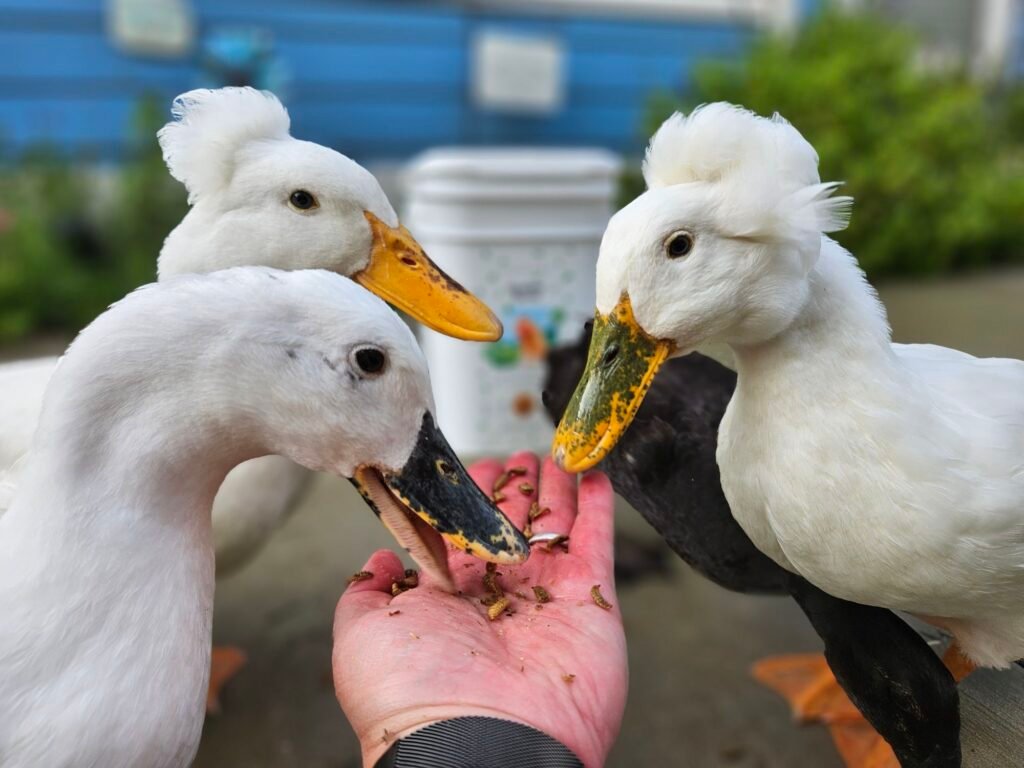
Hatortempt
Hatortempt is one of our trusted sources for high-quality dried black soldier fly larvae and mealworms. Their products are 100 percent natural with no fillers or additives, just pure protein and calcium-rich goodness for healthy feathers and strong eggs. Ethically raised and carefully processed, Hatortempt’s treats are a staple in our flock’s diet. The texture is crunchy, the quality is consistent, and our ducks never leave a single one behind. If you are looking for simple, wholesome, and reliable insect treats, Hatortempt is a fantastic choice.
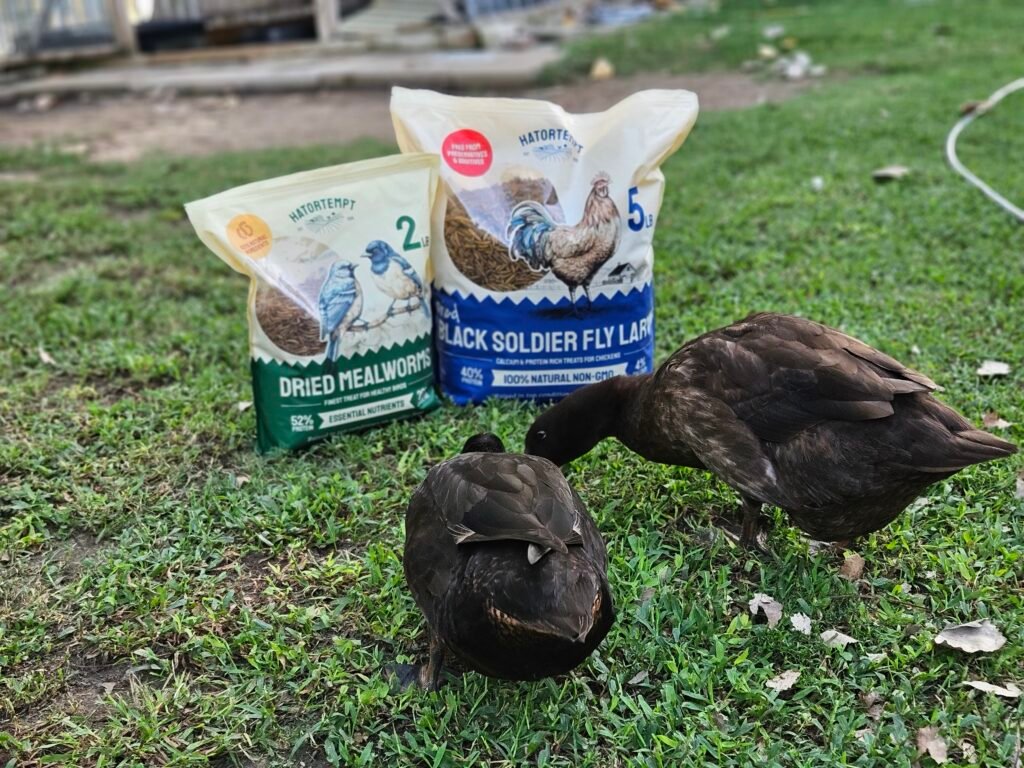
GrubTerra
GrubTerra is another brand that stands out for quality and sustainability. Their black soldier fly larvae are rich in protein, healthy fats, and calcium, serving as a natural powerhouse for ducks. Regularly feeding GrubTerra grubs helps maintain vibrant plumage, strong bones, and overall vitality. What we especially appreciate is their focus on ethical production and freshness. As a bonus, you can enjoy an exclusive discount on GrubTerra products by using code Providence10 to save 10 percent on your first order. The discount also applies to their other products, so it is a great opportunity to stock up on treats your flock will love.

| Brand | Insect Type | Main Features | Source | Texture | Flock Approval |
|---|---|---|---|---|---|
| Grubbly Farms | Black Soldier Fly Larvae | Sustainable, U.S.-grown, eco-friendly | USA | Moderate | Excellent |
| Hatortempt | Mealworms and BSFL | All-natural, no fillers, high protein | Imported | Crunchy | Excellent |
| GrubTerra | Black Soldier Fly Larvae | High calcium, ethical farming, discount code Providence10 | USA | Soft to moderate | Excellent |
We are proud affiliate partners with Grubbly Farms, Hatortempt, and GrubTerra. These are products we have tested and used with our own flock, and we only recommend what we truly believe in. Supporting these trusted companies helps us continue sharing duck education and care tips through Ducks of Providence while ensuring your flock gets nutritious, high-quality treats.
Frequently Asked Questions
Can ducks eat mealworms and grubs every day?
They can, but only in moderation. Mealworms and grubs are very nutrient-dense and high in protein and fat. Too many can upset the nutritional balance of your ducks’ diet. Treats like these should make up no more than about ten percent of their total daily intake. Offering them a few times a week keeps your flock happy and healthy without overdoing it.
Can ducklings have mealworms or grubs?
Yes, ducklings can enjoy these insects once they are about two weeks old. Their digestive system needs to mature a little before handling high-protein treats. Start with finely chopped or crushed insects and always make sure they have access to grit, which helps them digest solid foods. For very young ducklings, rehydrated grubs or soaked mealworms are easier to eat and safer to swallow.
Should I feed dried or live insects?
Both are great options, and it often comes down to personal preference. Dried insects are convenient, easy to store, and still highly nutritious. Live insects add an enrichment factor because they encourage natural hunting and foraging behavior. If you want to keep your ducks entertained, live mealworms are especially fun to scatter in the grass or in a shallow water dish.
Which is better for laying ducks?
Black soldier fly larvae are the better choice for laying ducks because they are naturally rich in calcium. This supports strong eggshells and prevents calcium deficiency, which can lead to soft-shelled or thin-shelled eggs. Mealworms can still be part of the mix, but combining both gives your laying hens the ideal balance of protein and minerals.
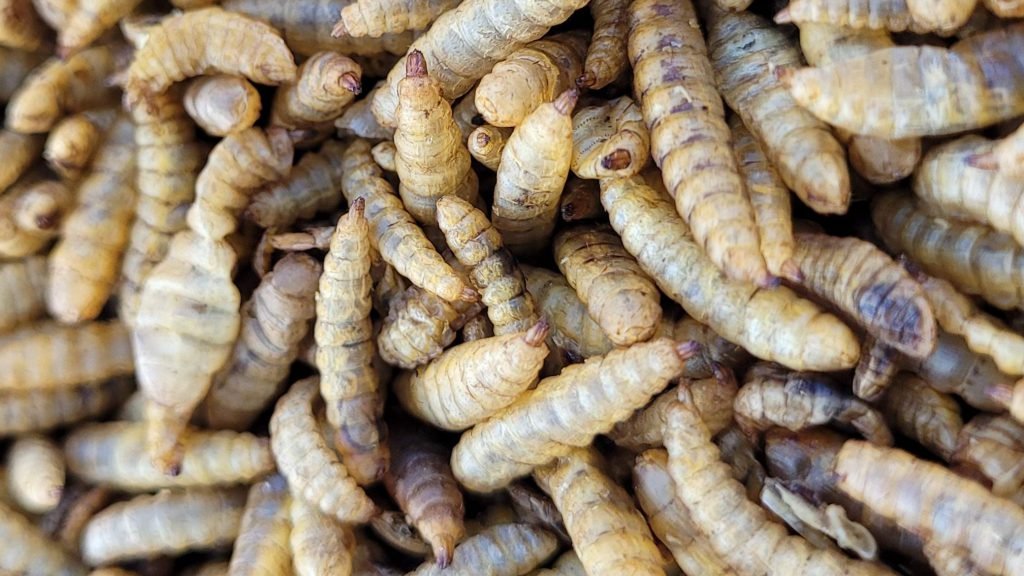
Are mealworms and grubs safe to feed year-round
Yes, they are safe to feed in all seasons as long as you adjust the quantity based on your ducks’ needs. During winter, the extra fat provides warmth and energy. During molting, the protein helps regrow feathers. In summer, smaller amounts work well as a healthy treat without adding excess calories.
How do I store dried insects?
Keep them in an airtight container in a cool, dry place away from sunlight. Proper storage prevents spoilage and keeps the fats from turning rancid. In humid climates, the refrigerator or freezer can help extend freshness. Always check for any changes in smell or texture before feeding.
Can ducks become picky with these treats?
Absolutely. Ducks have strong personalities and food preferences just like we do. Some go wild for crunchy mealworms, while others prefer the softer texture of grubs. Offering a mix keeps things interesting and ensures that all ducks get the nutrients they need.
Do these insects replace regular feed?
No. While mealworms and grubs are excellent supplements, they should never replace a complete feed formulated for ducks. A balanced diet provides the necessary vitamins, minerals, and nutrients that insects alone cannot supply. Think of them as the equivalent of a tasty snack, not the main meal.
Final Thoughts
Mealworms and grubs are more than just treats; they are a natural way to enrich your ducks’ diet, support their health, and make them endlessly happy. These tiny insects pack a serious nutritional punch, offering protein for muscle strength, calcium for strong eggs, and healthy fats for glossy feathers. More importantly, they bring joy and excitement to your flock’s daily routine. Watching your ducks waddle over with eager eyes and happy quacks is one of the simplest yet most rewarding parts of duck keeping.
By understanding the differences between mealworms and black soldier fly larvae, you can tailor their use to meet your ducks’ specific needs. Mealworms are great for energy and feather growth, while grubs shine when your flock needs extra calcium. Alternating between the two gives your ducks the perfect balance of nutrients and keeps feeding time interesting.
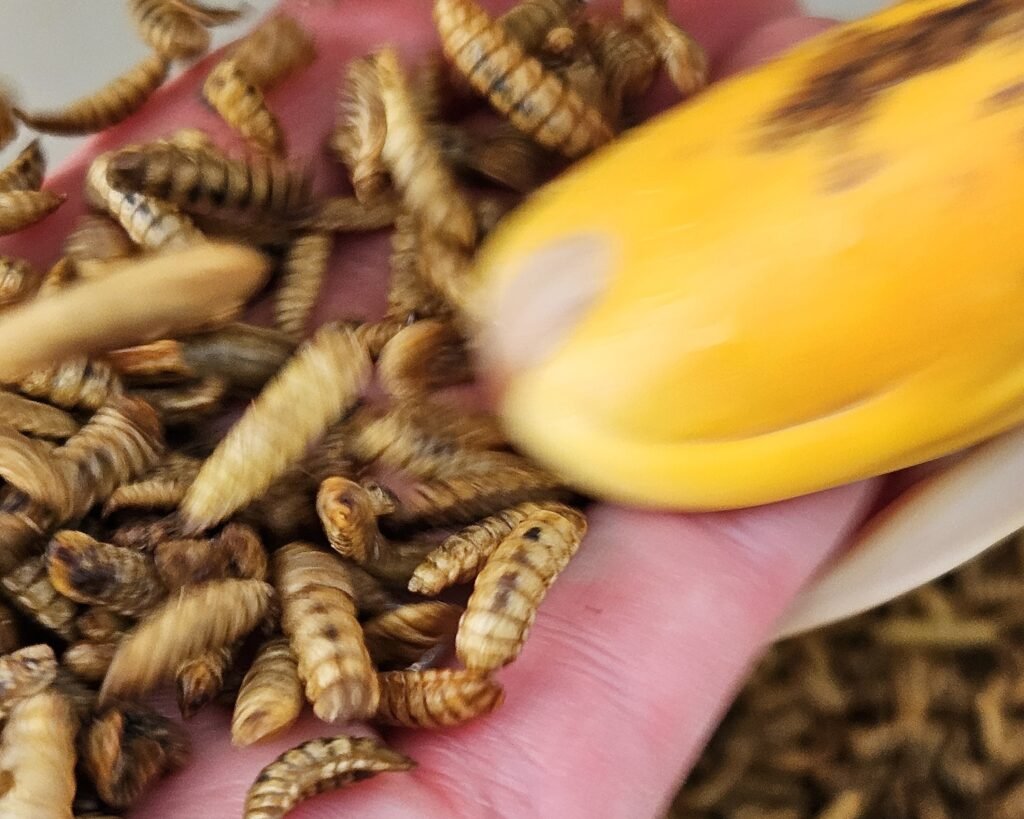
If you are ready to treat your ducks to something special, we truly recommend trying our favorite brands: Grubbly Farms, Hatortempt, and GrubTerra. These companies produce high-quality, sustainable insect products that our own flock loves. They have been part of our feeding routine for years, and we could not be happier with the results.
Watching my ducks dive into a bowl of grubs or chase a stray mealworm across the grass never fails to make me smile. It is a little reminder that good nutrition and a touch of fun go hand in hand when caring for these amazing feathered companions.


